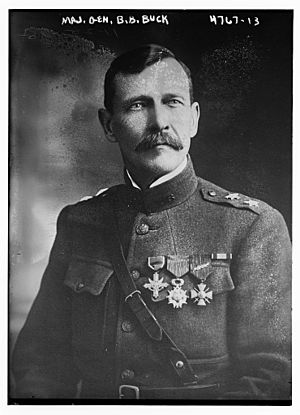Beaumont B. Buck facts for kids
Quick facts for kids
Major General
Beaumont Bonaparte Buck
|
|
|---|---|

Beaumont B. Buck, pictured here sometime in 1918 during World War I as a major general.
|
|
| Born | January 16, 1860 Mayhew, Mississippi, United States |
| Died | February 10, 1950 (aged 90) San Antonio, Texas, United States |
| Buried |
Fort Sam Houston National Cemetery, Texas, United States
|
| Allegiance | |
| Service/ |
|
| Years of service | 1885–1924 |
| Rank | |
| Service number | 0-151 |
| Unit | |
| Commands held | 28th Regiment 2nd Brigade 3rd Division 34th Division Camp MacArthur Camp Meade |
| Battles/wars | Spanish–American War Philippine–American War World War I |
| Awards |
|
Major General Beaumont Bonaparte Buck (born January 16, 1860 – died February 10, 1950) was an important officer in the United States Army. He served in three major wars: the Spanish–American War, the Philippine–American War, and World War I. He is most remembered for his leadership with the 1st Division during World War I. There, he commanded different groups of soldiers, from a regiment to a whole division.
Contents
Early Life and Training
Beaumont Bonaparte Buck was born in Mayhew, Mississippi, on January 16, 1860. His parents were James and Martha Garner Buck. When he was older, he went to the United States Military Academy (USMA) in West Point, New York. This is a famous school where future army officers are trained. He graduated from West Point in 1885. Many of his classmates also became generals in the army, just like him.
A Long Military Career
After finishing West Point, Buck became a second lieutenant in the U.S. Army Infantry Branch. His first job was serving on the frontier from 1885 to 1889. He also spent some time in the Philippines.
He then worked as a commandant of cadets at Baylor University and later at the University of Missouri. A commandant is like a leader or supervisor for students in military training.
When the Spanish–American War began in 1898, Buck joined as a major. After this war, he was promoted to captain. He also served three times in the Philippines during the Philippine–American War. In 1914, he became a colonel and was sent to the U.S.–Mexican border.
Leading in World War I
Just after the United States joined World War I in 1917, Buck became the commanding officer (CO) of the 28th Infantry Regiment. This group was part of the new 1st Division. Soon, his division was sent to France to fight.

Buck was promoted to brigadier general in August 1917. He then took command of the 2nd Brigade. He led this brigade in important battles like Cantigny and Soissons in 1918. For his bravery and leadership in capturing a town called Berzy-le-Sec during the Battle of Soissons, he received the Distinguished Service Cross (DSC). This is a very high award for military heroes.
In August 1918, Buck was promoted again to major general. He then took command of the 3rd Division. Under his command, the 3rd Division fought in the Battle of Saint-Mihiel and later in the Meuse–Argonne offensive.
During the Meuse-Argonne battle, General John J. Pershing, who was the top commander of the American forces, visited Buck's division. He saw that the troops were mixed up and not well organized. Because of this, General Pershing decided to replace Buck. This was to make sure the division could fight its best. Buck was not the only general replaced during this tough battle.
After this, Buck briefly commanded the 34th Division. The war ended soon after, on November 11, 1918.
After the War
Buck returned to the United States in November 1918. He took command of different army camps, including Camp MacArthur and Camp Meade. He also served near the Mexican–American border. His last assignment was helping to lead the 90th Division Organized Reserves.
Retirement and Later Life
Beaumont B. Buck retired from the army in 1924 as a colonel. He moved to San Antonio, Texas. In 1930, his full rank of major general was restored by Congress. He also wrote a book about his life and experiences called Memories of Peace and War in 1935.
Death and Legacy
Beaumont Bonaparte Buck lived in San Antonio, Texas, until he passed away on February 10, 1950. He was 90 years old. He was buried at Fort Sam Houston National Cemetery.

